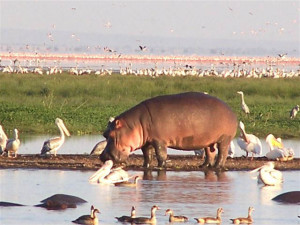Lake Manyara National Park
Lake Manyara National Park sits at the base of the Great Rift Valley escarpment and is one of the most scenic parks in Tanzania with many stunning views of the park from every direction.
From the east, the Rift Valley escarpment emerges on the horizon with the lake forming as a glistening background. On the southern side of the park, you will find the hot springs of Maji Moto, which are about 60ºC. At the top of the escarpment from the west side, the park stretches across a ribbon of green with the lake shining in the sun.
Manyara covers 320 square km, 231 square km being the vast alkaline lake that attracts loads of flamingo flocks forming a pink foam against the silver background of the water. Altogether, the area offers beautiful views as you take in the massive lake with its silver shimmer and surrounding vegetation. The diversity of its features makes the lake a particularly memorable place to visit.
Animals found in the area include Zebras, Elephant, Hippos, Velvet monkeys, Wildebeests, Water bucks, various antelope species, buffaloes, Warthogs, Hyenas, Olive baboons and Giraffes. Enjoy the endless views and the variety of mammals, reptiles and birds, as well as the varied flora .
HIGHLIGHTS:
The major landmark of this area is the spectacular rift wall, where the plains give way to the cultivated uplands of Mbulu land. The Great Rift Valley being part of a fault in the earth’s crust stretches about 8,000 km from Turkey to the mouth of the Zambezi River in Mozambique. The fault is so massive that it can be clearly seen from space.
Manayara is also most famous for its tree-climbing lions the majestic animals that find shelter from the heat and biting flies in the branches of trees, and they can easily kill buffalo – a formidable prey far greater in weight and size than themselves unlike the usual plains game.
Sightings of thousands of flamingos on the lake waters is also possible when they migrate here for breeding.
Manyara also hosts over 350 species of bird life, with a variety of local species inhabiting the forest and bush, including pelicans that waddle around next to the short grasses on the shores of the lake.



